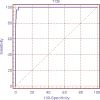The value of bilicheck® as a screening tool for neonatal jaundice in the South of iran
- PMID: 23825892
- PMCID: PMC3700058
The value of bilicheck® as a screening tool for neonatal jaundice in the South of iran
Abstract
The gold standard to assess jaundice in neonates is the serum bilirubin measurement. Blood sampling for the determination of total serum bilirubin (TSB) is painful for newborns and stressful for parents. The Bilicheck®, a new transcutaneous bilirubinometer, is considered as a more accurate measurement of bilirubin compared to the previous bilirubinometers courtesy of its advanced technology. The objective of this study was to evaluate the correlation between transcutaneous bilirubin (TcB) measurements using the Bilicheck® device and TSB in some Iranian neonates and to determine the most reliable cut-off value with the highest sensitivity and desirable specificity for bilirubin measured by the Bilicheck® on the forehead. This prospective observational study was conducted in 2011 on 560 healthy neonates with jaundice. TcB was measured using the Bilicheck® (Respironic, USA) within 30 minutes of TSB measurement via direct spectrophotometry. The results were assessed by simple linear regression analysis and receiver operative characteristic curve. There was good a correlation between TcB and TSB (r=0.969, r(2)=0.94), and this was not affected by sex, gestational age, postnatal age, and birth weight. TSB can be calculated through the measurement of TcB and use of the linear regression equation: TSB=-0.99+1.06TcB. Sensitivity and specificity of the Bilicheck® at the most reliable cut-off value (15 mg/dl) were 96.6% and 99%, respectively. The findings of the present study indicate that the Bilicheck® is a non-invasive, simple, easy, and reliable method for bilirubin measurement in neonatal jaundice, especially in neonates with bilirubin levels ≤15 mg/dl.
Keywords: Hyperbilirubinemia; Neonatal jaundice; Transcutaneous.
Figures






References
-
- Mercier CE, Barry SE, Paul K, Delaney TV, Horbar JD, Wasserman RC, et al. Improving newborn preventive services at the birth hospitalization: a collaborative, hospital-based quality-improvement project. Pediatrics. 2007;120:481–8. doi: 10.1542/peds.2007-0233. PubMed PMID: 17766519. - PubMed
-
- Rubaltelli FF, Gourley GR, Loskamp N, Modi N, Roth-Kleiner M, Sender A, et al. Transcutaneous bilirubin measurement: a multicenter evaluation of a new device. Pediatrics. 2001;107:1264–71. doi: 10.1542/peds.107.6.1264. PubMed PMID: 11389241. - PubMed
-
- Ebbesen F, Rasmussen LM, Wimberley PD. A new transcutaneous bilirubinometer, BiliCheck, used in the neonatal intensive care unit and the maternity ward. Acta Paediatr. 2002;91:203–11. doi: 10.1111/j.1651-2227.2002.tb01696.x. PubMed PMID: 11952010. - PubMed
-
- Nakamura T, Yamada D, Itakura Y, Ogawa Y. Clinical evaluation of a new device for transcutaneous bilirubin measurement in Japanese infants. J Saitama Med Sch. 2002;29:245–9.
-
- Engle WD, Jackson GL, Sendelbach D, Manning D, Frawley WH. Assessment of a transcutaneous device in the evaluation of neonatal hyperbilirubinemia in a primarily Hispanic population. Pediatrics. 2002;110:61–7. doi: 10.1542/peds.110.1.61. PubMed PMID: 12093947. - PubMed
LinkOut - more resources
Full Text Sources
